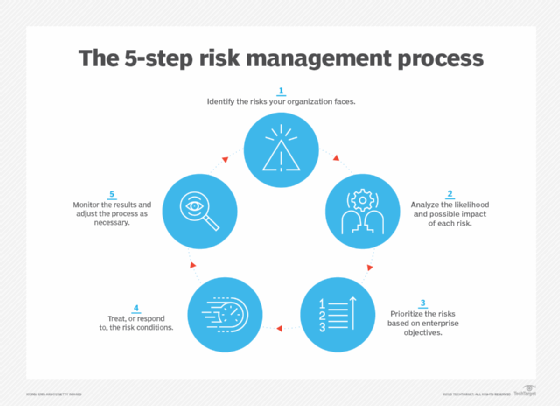How the Importance of Risk Management Shapes Effective Leadership
How the Importance of Risk Management Shapes Effective Leadership
Blog Article
The Essential Importance of Risk Management in Getting Business Goals
In the rapidly developing organization landscape, the capability to browse uncertainty has actually ended up being a crucial. This is where Risk Management actions in, giving an organized approach to recognizing, evaluating, and mitigating prospective obstacles to advance. It's greater than just a protective action - it's a tactical device, promoting resilience and advancement. As we discover the crucial role of Risk Management in achieving organizational objectives, one can not aid yet question: just how does this equate right into real-world success?
Comprehending the Principle of Risk Management in Company

The Indispensable Role of Risk Management in Strategic Preparation
Integrating Risk Management into tactical preparation acts as a safeguard for organizations, securing their lasting plans with a solid foundation of readiness and resilience. Risk Management offers a structure for preparing for uncertainties and developing suitable actions, guaranteeing the company's survival and prosperity also in the face of difficulty. By integrating Risk Management right into strategic planning, companies can transform these uncertainties into possibilities for development and advancement.

Methods for Identifying, Assessing, and Focusing On Dangers
Browsing the complex landscape of risks needs the application of certain techniques for their evaluation, prioritization, and recognition. The procedure starts with Risk recognition, employing tools such as SWOT evaluation, which helps in determining possible dangers and chances. Next off, Risk evaluation is conducted to identify the prospective impact and possibility of each Risk. Tools such as Risk matrices and impact-probability charts are made use of for this. Lastly, threats are prioritized based upon their prospective impact and possibility, enabling companies to focus their sources on critical risks. This methodical approach guarantees a detailed understanding of the Risk landscape, enabling organizations to make educated decisions and properly manage threats to achieve their objectives Learn More - importance of risk management.
Securing Business Procedures With Efficient Risk Management
In the business landscape stuffed with unpredictabilities, efficient Risk Management plays a crucial role in securing business operations. It works as a safety guard, reducing the adverse impacts of prospective threats and making sure the smooth performance of all processes. By determining and analyzing possible hazards, Risk Management makes it possible for organizations to develop durable contingency plans. This precautionary strategy help in keeping operational stability, also when confronted with unexpected situations. Basically, Risk Management is the lifeline that maintains the organizational operations afloat among unstable waters. It ensures not only the survival yet the sustainable development of an organization, making it a vital his comment is here tool in accomplishing business objectives. For this reason, companies have to spend in comprehensive Risk Management techniques to safeguard their operations.

Transforming Prospective Dangers to Opportunities: The Power of Risk Management
While potential dangers might originally look like obstructions to business success, reliable Risk Management can transform them right into chances. A proactive method to risk Management includes recognizing, evaluating, and focusing on threats to devise techniques that turn them into possible advantages. This procedure demands the growth of a risk-aware culture within the company, encouraging individuals to see dangers as prospective catalysts for modification and development, instead of simple threats. importance of risk management. With this lens, possible dangers end up being possibilities to introduce, boost processes, and strengthen strength. Thus, by leveraging the power of Risk Management, companies can not just safeguard their operations but additionally spur development and achieve their goals in an uncertain company environment.
Situation Studies: Success Stories of Risk Management Driving Organization Objectives
Effective implementation of Risk Management strategies has yielded outstanding cause numerous companies, underscoring the merits of this approach. International business like Microsoft and Google, as an example, have actually leveraged Risk Management to lessen dangers and exploit chances, driving their service objectives forward. Microsoft's proactive Risk Management approach helped it pivot swiftly during the 2020 pandemic, transitioning to remote job smoothly, thereby preserving productivity. Google, by evaluating and alleviating potential risks in its cloud-based solutions, has made certain undisturbed solution, thus enhancing client count on. These examples highlight how successful Risk Management can not only steer companies free from prospective pitfalls yet also guide them towards their critical purposes. Hence, Risk Management is integral to the search of organizational goals.
Verdict
To conclude, Risk Management is fundamentally critical in achieving organizational objectives. It uses an organized strategy to recognizing, evaluating, and dealing with potential threats and opportunities. Greater than simply mitigating dangers, it also promotes advancement, strength, and lasting development. By integrating Risk Management right into critical planning, organizations can much better browse uncertainties, safeguard procedures, and capitalise on opportunities, consequently straightening with long-lasting objectives.
At its core, Risk Management is the procedure of recognizing, evaluating, and resolving potential hazards that might adversely influence an organization's goals like this or operations. Next off, Risk assessment is conducted to establish the potential impact and likelihood of each Risk. Risks are focused on based on their possible influence and probability, allowing companies to focus their resources on high-priority dangers. By determining and assessing potential hazards, Risk Management allows companies to establish robust contingency plans. A proactive approach to risk Management includes recognizing, examining, and prioritizing threats to design methods that turn them into potential benefits.
Report this page